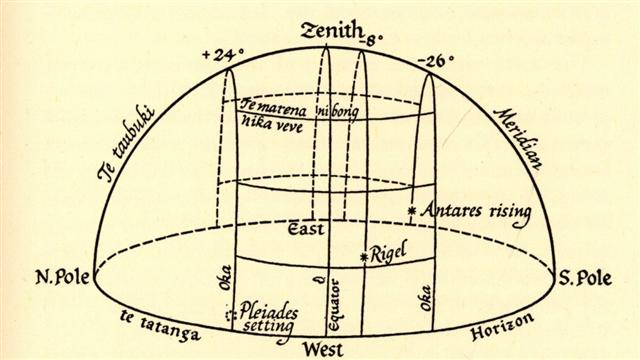463. It seems reasonable to assume
the night for breaking the coco on Hawaii
corresponded to the koti (similar to toki
'reversed') glyph Ca3-12, the night when the
Pleiades returned to visibility late in the northern
autumn.
| Koti.
Kotikoti.
To cut with scissors (since this is an old
word and scissors do not seem to have
existed, it must mean something of the
kind). Vanaga. Kotikoti. To tear;
kokoti, to cut, to chop, to hew, to
cleave, to assassinate, to amputate, to
scar, to notch, to carve, to use a knife, to
cut off, to lop, to gash, to mow, to saw;
kokotiga kore, indivisible;
kokotihaga, cutting, gash furrow. P
Pau.: koti, to chop. Mgv.:
kotikoti, to cut, to cut into bands or
slices; kokoti, to cut, to saw;
akakotikoti, a ray, a streak, a stripe,
to make bars. Mq.: koti, oti,
to cut, to divide. Ta.: oóti, to cut,
to carve; otióti, to cut fine.
Churchill. Pau.: Koti, to gush, to
spout. Ta.: oti, to rebound, to fall
back. Kotika, cape, headland. Ta.:
otiá, boundary, limit. Churchill. |
...
Judge Andrews in his Hawaiian-English Dictionary
observes the connection in Hawaiian ideas between
'speaking, declaring', and 'breaking'. The primary
idea, which probably underlies both, is found in the
Hawaiian 'to open, to separate, as the lips in
speaking or about to speak'; and it will be observed
that the same development in two directions shows
itself in all the Polynesian dialects, as well as in
several of the West Aryan dialects ...

...
The correspondence between the winter solstice
and the kali'i rite of the Makahiki
is arrived at as follows: ideally, the second
ceremony of 'breaking the coconut', when the
priests assemble at the temple to spot the
rising of the Pleiades, coincides with the full
moon (Hua tapu) of the twelfth lunar
month (Welehu). In the latter eighteenth
century, the Pleiades appear at sunset on 18
November. Ten days later (28 November), the
Lono effigy sets off on its circuit, which
lasts twenty-three days, thus bringing the god
back for the climactic battle with the king on
21 December, the solstice (= Hawaiian 16
Makali'i). The correspondence is 'ideal' and
only rarely achieved, since it depends on the
coincidence of the full moon and the crepuscular
rising of the Pleiades ...
...
In the Ilocos region of northern
Philippines, the Ilocano people fill two
halved coconut shells with diket (cooked
sweet rice), and place liningta nga itlog
(halved boiled eggs) on top of it. This ritual
is known as niniyogan and is an offering
made to the deceased and one's past ancestors.
This accompanies the palagip (prayer to
the dead).
A
coconut (Sanskrit:
narikela)
is an essential element of rituals in Hindu
tradition. Often it is decorated with bright
metal foils and other symbols of auspiciousness.
It is offered during worship to a Hindu god or
goddess. Irrespective of their religious
affiliation, fishermen of India often offer it
to the rivers and seas in the hopes of having
bountiful catches. Hindus often initiate the
beginning of any new activity by breaking a
coconut to ensure the blessings of the gods and
successful completion of the activity. The Hindu
goddess of well-being and wealth, Lakshmi,
is often shown holding a coconut. In the
foothills of the temple town of Palani,
before going to worship Murugan for the
Ganesha, coconuts are broken at a place
marked for the purpose. Every day, thousands of
coconuts are broken, and some devotees break
even 108 coconuts at a time as per the prayer.
In tantric practices, coconuts are sometimes
used as substitutes for human skulls. In Hindu
wedding ceremonies, a coconut is placed over the
opening of a pot, representing a womb ...
348 + 16 (nights in the rays from the
Sun) = 364.
 |
128 |
 |
44 |
|
Ca3-12 (63) |
Ca7-24 (192) |
|
348 / 2 = 174 = 6 * 29 |
| 393 + 349 = 742 = 1½ * 366 + 193 |
| 174 |
157 |
136 |
200 |
75 |
= 742 |
| 348 |
314 |
272 |
400 |
150 |
= 1484 |
| 522 |
471 |
408 |
600 |
225 |
= 2226 |
| 2226 = 1½ * 1484 |
 |
 |
 |
| Ca3-1 |
Ca3-2 |
Ca3-3 (54) |
| kiore - henua |
tapamea |
tagata rere ki te toki - te hau tea |
|
Toki. Small basalt axe. Vanaga. Stone adze. Van Tilburg. Ha'amoe ra'a toki = 'Put the adze to sleep' (i.e. hide it in the temple during the night). Barthel. Month of the ancient Rapanui calendar. Fedorova according to Fischer. To'i. T. Stone adze (e to'i purepure = with the wounderful adze). Henry. The Araukan Indians in the coastal area of northern Chile, have customs similar to those on the Marquesas and in both areas toki means adze according to José Imbelloni. The Araukans also called their chief of war toki and the ceremonial adze symbolized his function and was exhibited at the outbreak of war. In Polynesia Toki was the name of a chief elevated by the Gods and his sign was the blade of a toki. Fraser. Axe, stone hatchet, stone tool ...; maea toki, hard slates, black, red, and gray, used for axes T. P Pau.: toki, to strike, the edge of tools, an iron hatchet. Mgv.: toki, an adze. Mq.: toki, axe, hatchet. Ta.: toi, axe. Churchill. A Maori saying: he iti toki, e rite ana ki te tangata = though the adze be small, yet does it equal a man. (Starzecka)
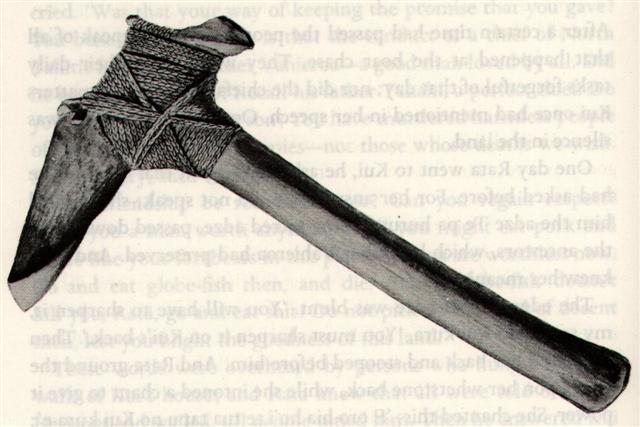
|
| CLOSE TO THE FULL MOON: |
| May 12
no star listed (52) |
13 (133 = 80 + 53)
ψ Persei (53.1)
ACRUX (α CRUCIS)
|
14
δ Persei (54.7) |
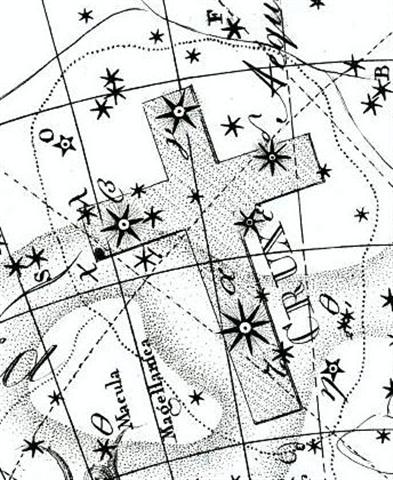 |
 |
 |
 |
 |
 |
| Ca3-4 |
Ca3-5 |
Ca3-6 |
Ca3-7 |
Ca3-8 (59 = 2 * 29½) |
| kiore ki te henua |
ihe tapamea |
e tagata mau toki ki te henua |
e hokohuki mau ki te matagi |
kiore i te henua |
|
Tapa. 1. Side, corner, edge; he-hakarere a te tapa, to leave aside, to abandon; a te tapa mata'u o te haga, on the right-hand side of the bay. 2. Tapa mahute, piece of mahute material; this term is very common nowadays, but it seems probable that it was borrowed from the Tahitian in replacement of parehe mahute. 3. To recount the years, the months; to recount happenings of many years ago, in verses called manu, in which a murderer confided his crime to his victim's relatives; the murderer himself asked a brother or a friend to compose those verses: e tapa koe itooku manu, compose my manu. The expression tapa ite manu was also used of a group of people expressing the desire to kill someone. 4. Tagata tapa ta'u, according to traditions, this term referred to the scribes who recorded births on the tablets. Vanaga. 1. Border, fringe, edge, groin, cloth, clothing, dress, garment. Tatapa, lateral, bank. Tapatapa, edge. P Mgv.: tapa, the edge of the bast cloth, bast cloth in general. Mq.: tapa, fringe, cloth. 2. To name, to mention, to count, to calculate, to reckon, to number, to figure up, to recapitulate; tapa ki te igoa, to take a census; tapa igoa, list. Tatapa, to count, to number, to reckon. Tapatapa, to mention. P Mgv.: tapa, to give a pet name. Mq.: tapatapa, to recite, to invoke; tatapa, to take the name of some one, to announce by name. Ta.: tapa, to call by name. Churchill.Mq.: Tapaau, coconut leaf plaited to serve as a mat. Sa: tapa'au, a coarse coconut leaf mat. Tapatai, a dweller on the strand. Ma.: tapatai, beach. Churchill.
Kapa¹, adj. Haw., rustling, rattling; s. cloth made of bark, cloth of any kind. Sam.: tapa, to beckon with the hand, to demand; s. the white border of a siapo; tapa-au, mat made of cocoa-nut leaf. Tong., tapa, id.; kapa-kapa, to flap with a noise as wings of birds. Marqu., tapa, bark cloth. Tah., tapa-ie, envelop in leaves; apa, the lining of a garment; apa-a, thick cloth made by men, not by the women; 'apa'apa, to flap as sail or the wings of a bird. Fiji., kava, a roll of sinnet; kaba, to climb. Motu (N. Guinea), kava, bark girdle for men. Biaju, tepoh, a mat. Salayer (Celebes), tupur, id. Malag., komba, a monkey. Kawi, kapala, a horse. Sanskr., kamp, to move to and fro, to tremble; chapala ('i.e., kampa-ala', Benfey), trembling, unsteady, giddy; châpala, quickness; kapi ('i.e., kamp-i', Benfey), a monkey. Perhaps kambala, a wollen blanket. Greek, καμπη, bending, winding, as a river, turn, trick, sudden change. A. Pictet (Orig. Ind.-Eur., i. 347-348) derives the Greek καβαλλης, a nag, and other kindred West Aryan forms for horse and its varieties, as well as καπρος, a wild boar, and caper, a buck, from the Kawi or obselete Sanskrit application of the original sense, 'to tremble, rustle, flap', found in the Sanskrit kap, kamp, and the Polynesian kapa, tapa. Kapa², s. Haw., a bank, shore, side, as of a river, lake, wood, or the like. Rarot., tapa, id. Tah., apa'apa, one side of a thing when divided, the side of a house. Sam., tafa, the side of a hill; v. to turn on one side; tafa-fa, four-sided; tafatafa, the side; tafa-tasi, one-sided; tafa-to, perpendicular, steep as seen from above; tafa-tu, id., as seen from below. Marqu., tapa-hai, coral; kapa-i, on the side of the sea. Fiji., taba, wing, shoulder, branch, one side. Malg., taf, tafo, the roof of a house; tambon, above. Welsh, tab, tav, an extended surface, a spread; tob, top, top, crest; cop, summit. Irish, capat, head. Armor., kab, id. Lat., tabula, board, plank, table; caput, head. Sanskr., kapala, skull, head, either half of an egg; kapola, cheek, the temples of the head. Pers., kabah, elevation, eminence; tabrak, tabûk, table, flat. Greek, κεφαλη, head, top, upper end. Goth., haubith, head. Sax., heafod, id.; hafala, hafula, head, casque. Anc. Germ., haupit, head; hufela, the temples. Germ., kopf, head. A. Pictet (loc. cit., ii. 273) refers the Persian tabrak and the Latin tabula to Sanskrit sthâ, or perhaps stabh, tabula, for stabula, and (i. 308) he says, speaking of the Sanskrit kapala, and its West Aryan relations: - 'J'y trouve un composé de pâla, protecteur, avec l'interrogatif ka, dans le sense laudatif. Quel (bon) protecteur! on ne saurait mieux caractériser le rôle naturel du crâne. Or kapât et kapâ ou kapa auraient la même signification; car pât, pâ, pa, à la fin des composés, sont synonymes de pâla, et dérivent également de la racine pâ, tueri.' Under correction, the 'quel bon protecteur' of Mr. Pictet appears to me a singular and fatal misnomer of the most prominent and most exposed part of the body. The original meaning of the Polynesian word was probably something raised, spread out, obtruding, projecting, beyond or above the common level of things. Hence such compound words in the Polynesian as kapa-au, Haw., the raised place of the Heiau (temple), where the image of the god stood and offerings were laid; 'apa-'au, Sam., a wing; 'apa-'apa, the fin of a fish; apa-ta, to clap the wings. The West Aryan forms: Lat., cap-ut, cap-pilus (capillus); the Irish cap-at, alongside of ceap and cap; the double forms in the Goth. and Sax., hau-ith, heaf-od, and hafa-la, hofu-la, seem to indicate a different composition and root for themselves, as well as the Sanskrit and Greek, than what Mr. Pictet offers. And the probably primary sense of 'elevation, eminence', in the root-word has survived in the Persian kabah, the Armorian kab, the Welsh tob or top. Fornander. |
| CLOSE TO THE FULL MOON: |
| May 15 (365 + 135 = 500)
Al Thurayya-27 (Many Little Ones) / Krittikā-3 (Nurses of Kārttikeya) / TAU-ONO (Six Stones)
ATIKS = ο Persei, RANA (Frog) = δ Eridani (55.1), CELAENO (16 Tauri), ELECTRA (17), TAYGETA (19), ν Persei (55.3), MAIA (20), ASTEROPE (21), MEROPE (23) (55.6) |
16 (136)
Hairy Head-18 (Cockerel) / Temennu-3 (Foundation Stone)
ALCYONE (56.1), PLEIONE (28 Tauri), ATLAS (27 Tauri) (56.3) |
17
MENKHIB (Next to the Pleiades = ζ Persei (57.6)
PORRIMA (γ Virginis)
|
18
ZAURAK (The Boat) = γ Eridani (58.9) |
19
λ Tauri (59.3), ν Tauri (59.9) |
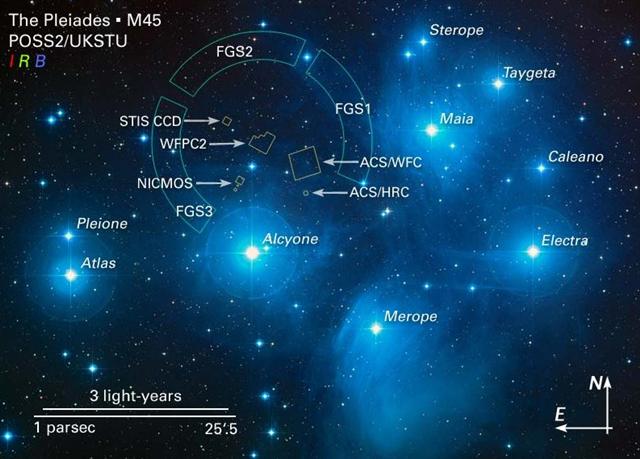 |
| JAN 19 |
20 |
21 (101 - 80) |
22 → Mercury |
| MARCH 17 (76 = 140 - 64) |
18 |
19 |
20 (79 = 22 + 3 * 19) |
 |
 |
 |
 |
| Ca3-9 |
Ca3-10 |
Ca3-11 |
Ca3-12 (63 = 7 * 9) |
| tapamea tagata kua iri |
ki te pa |
kua hua |
ki te kotiga |
|
Hua. 1. Testicle. 2. Figuratively: son, hua tahi, only son; fruits of the earth; to grow well (of fruits). 3. To cause a fight, a quarrel. Hua-ai, generation, as lineage of direct descendents; contemporaries. Huahua, coccyx of bird, 'parson's nose': huahua moa, huahua uha. Huataru, a creeper (Chenopodium ambiguum). Vanaga. 1. The same; ki hua, again, to continue, to strain, to struggle, to move, to repeat, over and above. Mq.: hua, the same, to return, to recommence. 2. To bloom, to sprout; flower, fruit (huaa); huaa tae oko, huaa vahio, young fruit; hua atahi, only son; huahaga, fruit; mei te huahaga o tokoe kopu, the fruit of thy body; tikea huahaga, deceptive appearance. P Pau.: ua, to be born; huahaga, lineage. Mgv.: hua, to produce (said of trees, grain, etc.), blooming time of flowers, abundance of fruit. Mq.: hua, to produce, to bear fruit. Ta.: ua, to sprout. Huahua. 1. Tailless fowl. 2. Vein, tendon, line. 3. Mgv.: huahua, pimples covering the face. Ta.: huahua, id. Mq.: hua, tubercules. Sa.: fuafua, abscess on hand or feet. Ma.: huahua, small pimples. Pau.: Hua-gakau, rupture. Ta.: áau, entrails. Sa.: ga'au, id. Ma.: ngakau, id. Churchill. 1. Fruit. 2. Egg. 3. Tā hua = 'genealogical writing' or 'same writing'. Fischer. |
| CLOSE TO THE FULL MOON: |
| May 20 (140)
4h (60.9)
JĪSHUĬ (Piled-up Waters) = λ Persei (60.7)
COR CAROLI (α Canum Ven.)
|
21
υ Persei (61.2) |
22 (21 + 121 = 142)
BEID (Egg) = ο¹ Eridani (62.2), μ Persei (62.8)
VINDEMIATRIX ( ε Virginis) |
23 (11 * 13 = 143)
Al Dabarān-2 (The Follower)
HYADUM I = γ Tauri (63.4)
*22 = *63.4 - *41.4 |
| 'April 23 (*60 - * 27 = *33) |
24 |
25 (115 → Mercury → Hermes Trismegistos) |
26 |
|
... [E:17] On the twenty-fifth day of the first month (Vaitu Nui), Ira and Makoi set sail; on the first day of June ('Maro'), the bow of Ira's canoe appeared on the distant horizon, came closer and closer on its course, and sailed along, and finally (one) could see the (new home) land ... |
| "April 9 (140 - 41 = 99) |
10 (100) |
11 (*21) |
12 |
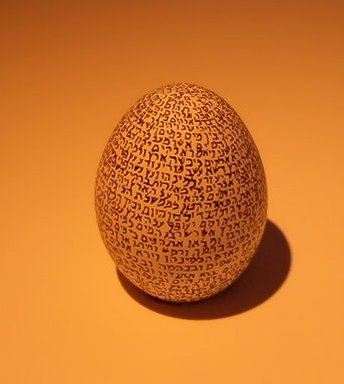 |
| CLOSE TO THE SUN: |
| Nov 19 (140 + 183 = 323)
16h (243.5)
ACRAB (Scorpion) = β Scorpii, JABHAT AL ACRAB (Forehead of the Scorpion) = ω Scorpii (243.3), θ Lupi, RUTILICUS = β Herculis (243.5), MARFIK (Elbow) = κ Herculis (243.7), φ Herculis (243.8) |
20
ψ Scorpii (244.6), LESATH (Sting) = ν Scorpii (244.8) |
21 (*245)
χ Scorpii (245.1), YED PRIOR (Hand in Front) = δ Ophiuchi, δ Tr. Austr. (245.5) |
22
YED POSTERIOR (Hand Behind) = ε Ophiuchi, RUKBALGETHI SHEMALI (Northern Knee of the Giant) = τ Herculis (246.6). δ Apodis (246.7), ο Scorpii (246.8) |
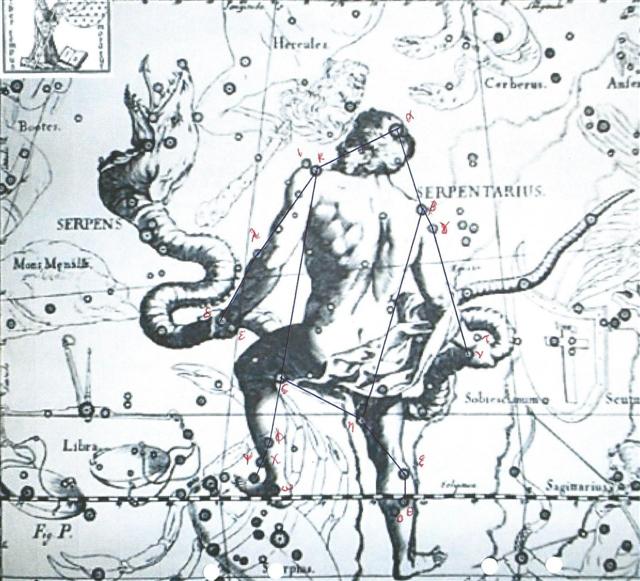 |
| JAN 23 (= 80 - 57) |
24 |
25 |
26 |
| MARCH 21 (80 = 144 - 64) |
22 (*1) |
23 |
24 |
 |
 |
 |
 |
| Ca3-13 |
Ca3-14 (65 = 5 * 13) |
Ca3-15 |
Ca3-16 |
| kiore i te henua |
tapamea - tagata hoi hatu |
ki te ariki |
kiore i te henua |
| CLOSE TO THE FULL MOON: |
| May 24 (144 = 80 + 64)
HYADUM II = δ¹ Tauri (64.2) |
25
Net-19 (Crow)
AIN (Eye) = ε Tauri, θ¹ Tauri, θ² Tauri (65.7) |
26
no star listed (66) |
27
no star listed (67) |
 |
| CLOSE TO THE SUN: |
| Nov 23 (144 + 183 = 327)
Heart-5 (Fox)
σ SCORPII (247.0), HEJIAN = γ Herculis (247.2), ψ Ophiuchi (247.7) |
24
ρ Ophiuchi (248.1), KAJAM (Club) = ω Herculis (248.3), χ Ophiuchi (248.5), SHE LOW (Market Tower) = υ Ophiuchi, Tr. Austr. (248.7), ζ Tr. Austr. (248.8) |
25
Al Kalb-16 (The Heart) / Jyeshtha-18 (Eldest) / ANA-MUA-1 (Entrance pillar)
ANTARES = α Scorpii (249.1), MARFIK (Elbow) = λ Ophiuchi, φ Ophiuchi (249.5), ω Ophiuchi (249.8) |
26 (*250)
γ Apodis (250.1), σ Herculis (250.3), θ Tr. Austr. (250.6), τ Scorpii (250.7) |
| JAN 27 |
28 |
29 |
30 |
| MARCH 25 (84 = 27 + 57) |
26 |
27 |
28 |
 |
 |
 |
 |
| Ca3-17 (84 - 16 = 68) |
Ca3-18 (69) |
Ca3-19 |
Ca3-20 → Dramasa |
| tapamea - tagata rima iri |
te henua te hokohuki |
te kava |
te kiore i te henua |
| CLOSE TO THE FULL MOON: |
|
May 28 (148)
Rohini-4 (The Red One) / Pidnu-sha-Shame-4 (Furrow of Heaven) / ANA-MURI-2 (Rear pillar - at the foot of which was the place for tattooing)
ALDEBARAN = α Tauri (68.2), THEEMIN = υ² Eridani (68.5) |
29
no star listed (69) |
30 (→ 5 * 30 = 150)
no star listed (70) |
31
TABIT = π³ Orionis (71.7), π² Orionis (71.9)
320 (South Pole star, Dramasa) - 71 (Tabit) = 249 (Antares) |
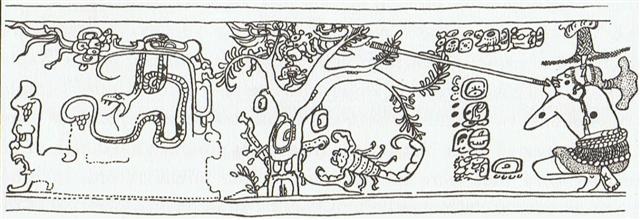
... This pot depicts one of the Hero Twins (One-Ahaw in the Classic texts and One-Hunaphu in the K'iche' Popol Vuh) and a great bird who is trying to land in a huge ceiba tree heavy with fruit. This mythical bird is Itzam-Yeh, Classic prototype of Wuqub-Kaqix, 'Seven-Macaw', of Popol Vuh fame. In that story, in the time before the sky was lifted up to make room for the light, the vainglorious Seven-Macaw imagined himself to be the sun. Offended by his pride, the Hero Twins humbled him by breaking his beautiful shining tooth with a pellet from their blowgun. This pot shows One-Ahaw aiming at the bird as he swoops down to land in his tree. As Itzam-Yeh lands on his perch, the text tells us he is 'entering or becoming the sky'. This particular 'sky-entering' is not the one mentioned in the Palenque text. It is the final event that occurred in the previous creation before the universe was remade. Before the sky could be raised and the real sun revealed in all its splendor, the Hero Twins had to put the false sun, Itzam-Yeh, in his place. If the date on this pot corresponds to that pre-Creation event, as we believe it does, then Itzam-Yeh was defeated in 12.18.4.5.0 1 Ahaw 3 K'ank'in (May 28, 3149 B.C.) ... |
| CLOSE TO THE SUN: |
| Nov 27 (148 + 183)
HAN = ζ Ophiuchi (251.0) |
28 (332 = 149 + 183)
ζ Herculis, η Tr. Austr. (252.1), η Herculis, β Apodis (252.5) |
29 (300 + 33)
ATRIA = α Tr. Austr. (253.9) |
30 (*254 = *71 + *183)
Tail-6 (Tiger)
WEI (Tail) = ε Scorpii, η Arae (254.3), DENEBAKRAB = μ Scorpii (254.7) |
3 days after Ca3-12 (63 = 9 * 7) -
similar to the Chinese 3 days' of cold food - was
the place for Antares (the Entrance Pillar), rising
with the Sun in November 25 (329 → 3-29 → 88 →
Betelgeuze) → 22 * 4.
...
Odysseus and his fleet were now in a mythic
realm of difficult trials and passages, of which
the first was to be the Land of the Cyclopes,
'neither nigh at hand, nor yet afar off', where
the one-eyed giant Polyphemus, son of the god
Poseidon (who, as we know, was the lord of tides
and of the Two Queens, and the lord,
furthermore, of Medusa), dwelt with his flocks
in a cave.
'Yes, for he was a monstrous
thing and fashioned marvelously, nor was he like
to any man that lives by bread, but like a
wooded peak of the towering hills, which stands
out apart and alone from others.'
Odysseus, choosing
twelve men, the best of the
company, left his ships at shore and sallied to
the vast cave. It was found stocked abundantly
with cheeses, flocks of lambs and kids penned
apart, milk pails, bowls of whey; and when the
company had entered and was sitting to wait,
expecting hospitality, the owner came in,
shepherding his flocks.
He bore a grievous weight of
dry wood, which he cast down with a din inside
the cave, so that in fear all fled to hide.
Lifting a huge doorstone, such as two and twenty
good four-wheeled wains could not have raised
from the ground, he set this against the mouth
of the cave, sat down, milked his ewes and
goats, and beneath each placed her young, after
which he kindled a fire and spied his guests
...
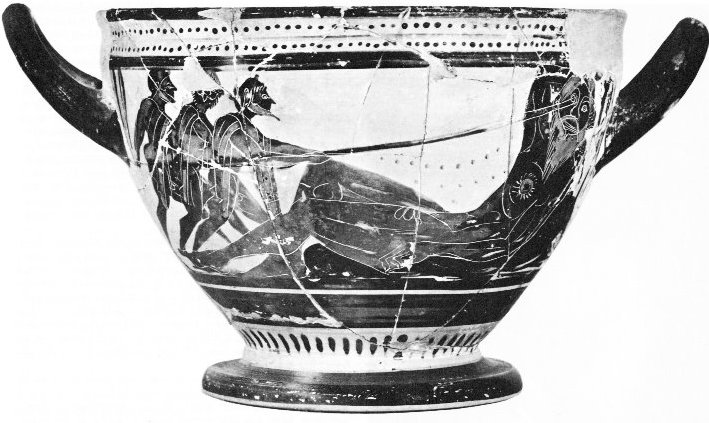
... The
total number of notches (88) not only coincides with
the number of days in 3 lunations (88.5) but also
approximately with the number of days when the star
Betelgeuse (α
Ori) disappeared from view each year between its
heliacal set (about 14 days before the spring
equinox around 33,000 BP) and its heliacal rise
(approximately 19 days before the summer solstice).
Conversely, the nine-month period when Orion was
visible in the sky approximately matched the
duration of human pregnancy, and the timing of the
heliacal rise in early summer would have facilitated
a ‘rule of thumb’ whereby, by timing conception
close to the reappearance of the constellation, it
could be ensured that a birth would take place after
the severe winter half-year, but leaving enough time
for sufficient nutrition of the baby before the
beginning of the next winter ...
From Alcyone (*56 = 8 * 7) to Hyadum
I (*63) there was a week, and 7 + 3 = 10 days after
Alcyone was the place for Antares rising (*249 = *56
+ *183 + *10):
The circuit of Lono began 10
days after Alcyone returning to visibility and this
indicates Lono (Rogo) ought to be another name
for Antares.
|
